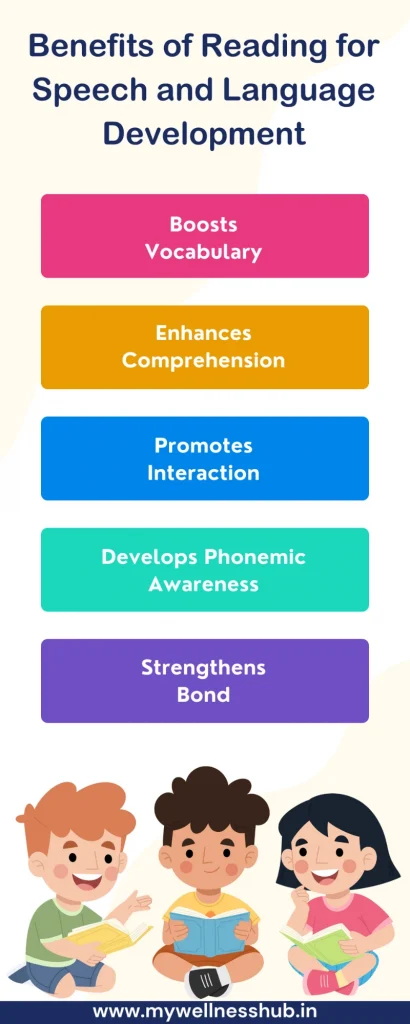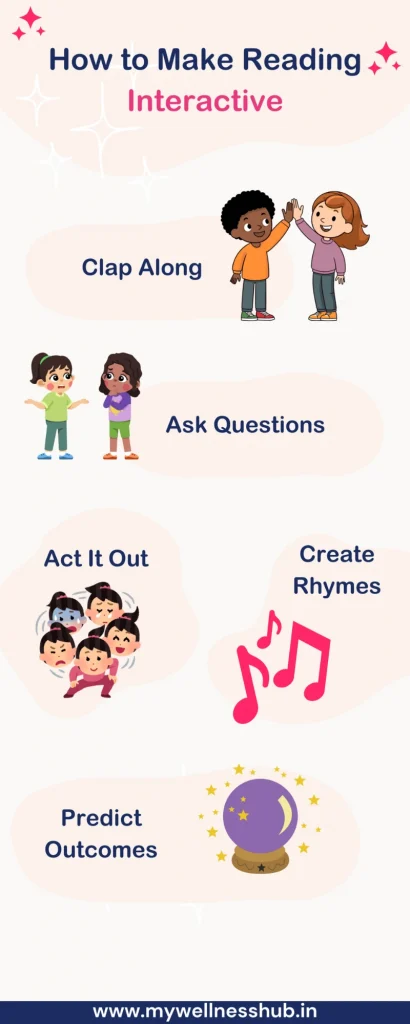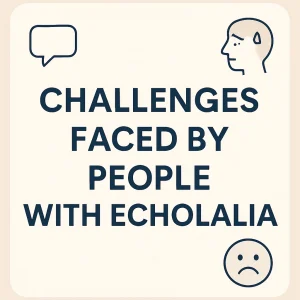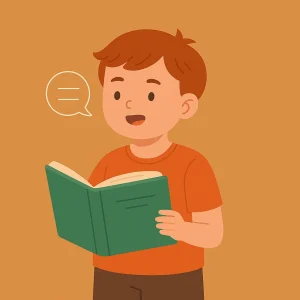6 Amazing Children’s Books for Speech and Language Growth
Last Updated: June 8, 2024
Reading plays a crucial role in developing children’s speech and language skills. From the time they are infants, children absorb language by listening to the sounds, rhythms, and patterns of speech around them. As they grow, books become a powerful tool to enhance this natural learning process. Whether you are reading to a baby or discussing stories with a preschooler, incorporating books into your child’s routine can significantly boost their language development.
Books are not just for entertainment; they are a fun and effective way to engage children in learning. When you read together, you create opportunities to expand their vocabulary, improve their comprehension, and foster a love for language. Each story opens up a world of new words and ideas, making language learning an enjoyable and interactive experience.

1. “Goodnight Moon” by Margaret Wise Brown
“Goodnight Moon” is a beloved classic that has soothed countless children to sleep with its gentle rhythm and comforting repetition. This bedtime story features a cozy room with familiar objects, each named and bid goodnight by a little bunny. The repetitive phrases and calming illustrations make it an ideal choice for helping young children develop their speech and language skills.
Language Skills Developed:
- Identifying Objects: As you read, point out and name the various objects in the room, such as the “red balloon,” “toy house,” and “pair of socks.” This helps your child learn to identify and name everyday items.
- Labeling Items: Repeating the names of objects on each page reinforces vocabulary and helps with language retention.
- Imitating Phrases: Encourage your child to repeat the soothing phrases, such as “Goodnight moon” and “Goodnight stars.” This repetition is key to developing their ability to imitate speech and build longer phrases.
Interactive Tips:
- Point to and Name Objects: As you read, point to the items on each page and clearly name them. For example, say, “Look, there’s the red balloon” while pointing to the balloon in the picture. This helps your child make connections between the words and the objects they represent.
- Encourage Your Child to Repeat Phrases: After you say a phrase, pause and encourage your child to repeat it. For instance, after you say, “Goodnight room,” wait and let your child try to say it too. This practice helps them learn new words and phrases in a fun, engaging way.
- Ask Questions About the Pictures: Engage your child by asking simple questions about the illustrations. You could ask, “Can you find the cow jumping over the moon?” or “Where is the little mouse hiding?” These questions promote observation skills and help your child practice responding verbally.
Also read: Tips to Develop Good Learning Habits
2. “Where the Wild Things Are” by Maurice Sendak
“Where the Wild Things Are” is a timeless tale that takes children on a journey of adventure and imagination. With its rich, descriptive language and captivating illustrations, this story offers numerous opportunities to enhance your child’s language skills.
Language Skills Developed:
- Vocabulary Expansion: The story’s imaginative setting and unique characters introduce children to new words and phrases.
- Storytelling: Following Max’s journey helps children understand narrative structure and sequencing.
- Answering Questions: Discussing the plot and characters encourages children to think critically and articulate their thoughts.
Interactive Tips:
- Discuss the Emotions and Actions of the Characters: Ask your child how Max might be feeling at different points in the story. For example, “How do you think Max feels when he first arrives where the wild things are?” This helps children connect words with emotions and actions, enhancing their emotional intelligence and vocabulary.
- Encourage Your Child to Describe What They See and What Might Happen Next: Pause on each page and ask your child to describe the scene. Questions like “What do you see?” or “What do you think will happen next?” engage their imagination and promote verbal expression.
- Act Out Parts of the Story to Make It Interactive: Turn reading time into playtime by acting out scenes from the book. Pretend to be Max and the wild things, using facial expressions and movements to bring the story to life. This not only makes reading fun but also helps with understanding and retaining new words and phrases.
3. “The Very Hungry Caterpillar” by Eric Carle
“The Very Hungry Caterpillar” by Eric Carle is a beloved classic that captivates children with its vibrant illustrations and simple, repetitive text. This book is excellent for teaching important concepts such as counting, the days of the week, and the names of various foods.
Language Skills Developed:
- Sequencing: The story’s structure, which follows the caterpillar’s journey through different foods and days, helps children understand the concept of sequencing.
- Counting: As the caterpillar eats more food each day, children can practice counting the items.
- Vocabulary Building: The book introduces various food names and descriptive phrases, expanding your child’s vocabulary.
Interactive Tips:
- Count the Foods Together: As you read, count the foods along with your child. For example, “On Monday, he ate through one apple. On Tuesday, he ate through two pears.” This practice reinforces counting skills in a fun, engaging way.
- Name Each Food Item and Encourage Your Child to Repeat: Point to each food item and clearly say its name. Encourage your child to repeat after you. For instance, “This is a plum. Can you say plum?” This activity helps with vocabulary building and pronunciation.
- Discuss the Lifecycle of the Caterpillar: Use the story to talk about the caterpillar’s transformation into a butterfly. Explain the lifecycle stages in simple terms, such as “First, the caterpillar is an egg. Then, it hatches and eats a lot. After that, it becomes a chrysalis. Finally, it turns into a beautiful butterfly.” This discussion not only enhances vocabulary but also introduces basic scientific concepts.
“The Very Hungry Caterpillar” is more than just a charming story; it’s a powerful tool for developing sequencing, counting, and vocabulary skills. By making reading interactive, you can help your child learn and grow while enjoying a classic tale together.
Know more about the article on Smart Reading Techniques for Students
4. “Giraffes Can’t Dance” by Giles Andreae
“Giraffes Can’t Dance” is a delightful rhyming story about a giraffe named Gerald who finds his own rhythm and confidence. This engaging tale uses beautiful illustrations and a fun, rhythmic text to captivate children while teaching valuable lessons about self-expression and confidence.

Language Skills Developed:
- Rhyming: The rhyming text helps children recognize and produce rhyming words, an important pre-reading skill.
- Rhythm: Clapping along with the story’s rhythm enhances auditory discrimination and phonological awareness.
- Expressing Emotions: Gerald’s journey allows children to explore and articulate emotions, relating them to their own experiences.
Interactive Tips:
- Clap Along to the Rhythm of the Story: As you read, clap along to the rhythm of the rhyming text. This not only makes the reading session more interactive but also helps your child develop a sense of rhythm and timing. For example, “Gerald was a tall giraffe, whose neck was long and slim”—clap along to the beat to emphasize the rhythm.
- Discuss the Emotions of the Giraffe and Relate to Your Child’s Experiences: Talk about how Gerald feels at different points in the story. Ask your child questions like, “How do you think Gerald felt when the other animals laughed at him?” and “Have you ever felt nervous about trying something new?” This encourages empathy and helps children express their own feelings.
- Encourage Your Child to Make Up Their Own Rhymes: After reading the story, have fun making up new rhymes together. Start with simple words and see how many rhymes you can create. For instance, take the word “dance” and come up with rhymes like “chance,” “prance,” and “glance.” This playful activity enhances phonemic awareness and creativity.
“Giraffes Can’t Dance” is more than just a charming tale; it’s a wonderful resource for developing rhyming, rhythm, and emotional expression skills. By incorporating these interactive tips, you can make the reading experience both enjoyable and educational for your child.
5. “Chicka Chicka Boom Boom” by Bill Martin Jr. and John Archambault
“Chicka Chicka Boom Boom” is an engaging alphabet book that has captivated young readers for generations. Its catchy rhythm and vibrant illustrations make learning the alphabet a fun and memorable experience.
Language Skills Developed:
- Alphabet Recognition: The story features the entire alphabet, helping children recognize and name each letter.
- Phonemic Awareness: By focusing on the sounds that letters make, children develop essential pre-reading skills.
- Rhyming: The rhythmic, rhyming text helps children understand and produce rhymes, which is crucial for language development.
Interactive Tips:
- Sing the Alphabet Song Together: Singing the alphabet song while reading “Chicka Chicka Boom Boom” reinforces letter recognition in a fun and engaging way. You can sing the song slowly, pointing to each letter in the book as you go along. This helps your child make the connection between the letters they see and the sounds they hear.
- Identify Letters and Their Sounds: Take time to point out and name each letter in the story. For example, say, “This is the letter A. A sounds like /a/ as in apple.” Encourage your child to repeat the letter name and sound after you. This activity builds phonemic awareness, a critical skill for reading readiness.
- Make Up Additional Rhymes Using Different Letters: After reading the book, have fun creating your own rhymes with the alphabet. Choose a letter and come up with words that rhyme. For example, with the letter B, you might say, “B is for bee, and it likes to be free.” This playful exercise not only reinforces letter sounds but also encourages creativity and language play.
“Chicka Chicka Boom Boom” is more than just a lively alphabet book; it’s a valuable tool for developing key language skills. By incorporating these interactive tips, you can make learning the alphabet an enjoyable and enriching experience for your child.
6. “Press Here” by Hervé Tullet
“Press Here” by Hervé Tullet is an engaging and interactive book that invites children to press, shake, and tilt the book to see what happens next. This playful approach makes learning fun and captivating.
Language Skills Developed:
- Following Instructions: The book’s format encourages children to follow simple instructions, enhancing their ability to listen and act accordingly.
- Cause and Effect: As children interact with the book and see the results of their actions, they develop an understanding of cause and effect.
- Verbal Interaction: Discussing the actions and outcomes in the book promotes verbal communication and encourages children to express their thoughts.
Interactive Tips:
- Follow the Book’s Instructions and See What Happens on Each Page: Encourage your child to follow the book’s instructions, such as pressing a dot or shaking the book. For example, “Press the yellow dot and see what happens next!” This activity helps children understand the connection between instructions and actions, enhancing their listening skills.
- Discuss Cause and Effect as You Press the Dots: Talk about what happens after each interaction. For instance, “What do you think will happen if we press the red dot?” and then observe the result together. This discussion helps children grasp the concept of cause and effect, making learning interactive and engaging.
- Encourage Your Child to Predict What Will Happen Next: Before turning the page, ask your child to guess what might happen next. For example, “What do you think will happen if we shake the book?” This encourages critical thinking and verbal expression as your child articulates their predictions.
“Press Here” is not just an interactive book; it’s a fantastic tool for developing essential language skills. By incorporating these interactive tips, you can create a fun and educational reading experience that promotes following instructions, understanding cause and effect, and enhancing verbal interaction.
Interactive Tips for Each Book
| Book Title | Interactive Tip 1 | Interactive Tip 2 | Interactive Tip 3 |
|---|---|---|---|
| Goodnight Moon | Point to and name objects | Encourage repeating phrases | Ask questions about pictures |
| Where the Wild Things Are | Discuss emotions and actions | Describe scenes and predict outcomes | Act out parts of the story |
| The Very Hungry Caterpillar | Count the foods together | Name each food item and encourage repeating | Discuss the lifecycle of the caterpillar |
| Giraffes Can’t Dance | Clap along to the rhythm | Discuss emotions and relate to experiences | Encourage making up their own rhymes |
| Chicka Chicka Boom Boom | Sing the alphabet song together | Identify letters and their sounds | Make up additional rhymes with letters |
| Press Here | Follow the book’s instructions | Discuss cause and effect | Predict what will happen next |
Explore more on Tips on Writing Skills that Help Students
Conclusion
Incorporating these six amazing children’s books into your reading routine can greatly improve your child’s speech and language development. Each book offers unique ways to build important skills like vocabulary, phonemic awareness, sequencing, and expressing emotions. By making reading interactive and fun, you can help your child learn in a meaningful way. Reading together not only helps with language development but also strengthens your bond with your child.
Make reading a daily habit to get the most benefits. Remember, the key is to make it enjoyable and interactive. At Wellness Hub, we are here to support you and your child on this journey. Explore our website for more resources and tips to help your child thrive. Using these books and tips can give your child a strong foundation for communication and lifelong learning.
Frequently Asked Questions:
1. What are the best children’s books for speech and language development?
Some of the best children’s books for speech and language development include “Goodnight Moon” by Margaret Wise Brown, “Where the Wild Things Are” by Maurice Sendak, “The Very Hungry Caterpillar” by Eric Carle, “Giraffes Can’t Dance” by Giles Andreae, “Chicka Chicka Boom Boom” by Bill Martin Jr. and John Archambault, and “Press Here” by Hervé Tullet. These books are engaging and interactive, helping children build vocabulary, phonemic awareness, sequencing, and emotional expression skills.
2. How can reading books help with my child’s speech development?
Reading books helps with speech development by introducing new vocabulary, enhancing phonemic awareness, and improving comprehension skills. Interactive reading sessions, where you ask questions and encourage your child to repeat phrases, can also strengthen their ability to express themselves verbally.
3. Why is “Goodnight Moon” recommended for language growth?
“Goodnight Moon” is recommended for language growth because it uses repetitive phrases and familiar objects, making it easy for children to identify and name items. This repetition helps with vocabulary building, and the soothing rhythm aids in calming children before bedtime, making it an excellent choice for developing language skills.
4. What language skills does “The Very Hungry Caterpillar” develop?
“The Very Hungry Caterpillar” helps develop sequencing, counting, and vocabulary skills. The story follows the caterpillar’s journey through various foods and days of the week, providing a structured sequence that children can follow and understand. It also introduces different food names, enhancing vocabulary.
5. How can I make reading more interactive for my child?
To make reading more interactive, you can ask your child questions about the story, encourage them to repeat phrases and act out parts of the book together. For example, clap along to the rhythm in “Giraffes Can’t Dance” or press the dots in “Press Here” to see what happens next. These activities make reading fun and engaging while promoting language development.
6. Why is rhyming important for language development?
Rhyming is important for language development because it helps children recognize and produce similar sounds, which is a key component of phonemic awareness. Books like “Chicka Chicka Boom Boom” use rhyming text to teach children about sounds and letters, making it easier for them to learn to read and spell.
7. Can reading books help with emotional development?
Yes, reading books can help with emotional development. Stories like “Giraffes Can’t Dance” and “Where the Wild Things Are” explore emotions and encourage children to express their feelings. Discussing the characters’ emotions and relating them to your child’s experiences can enhance their emotional intelligence.
8. How often should I read to my child to support speech and language development?
Reading to your child daily is ideal for supporting speech and language development. Even just 15-20 minutes a day can make a significant difference. Consistency is key, and integrating reading into your daily routine helps reinforce language skills and fosters a love for reading.
9. What types of questions should I ask my child during reading to enhance language skills?
Ask open-ended questions that encourage your child to think and respond. For example, “What do you think will happen next?” or “How does the character feel?” These types of questions help develop critical thinking, comprehension, and verbal expression. Also, asking them to identify objects and describe scenes can boost vocabulary.
10. How can I help my child with phonemic awareness using books?
To help your child with phonemic awareness, choose books with rhymes, repetitive text, and engaging sounds. Encourage your child to repeat rhyming words and sounds and play games that focus on identifying the beginning and ending sounds of words. Books like “Chicka Chicka Boom Boom” are excellent for this purpose, as they combine rhymes with alphabet learning.
About the Author:
Anuradha Karanam
Speech-language pathologist (7+ years of experience)
Anuradha Karanam is a skilled speech-language pathologist with over 6 years of experience. Fluent in Tamil, Telugu, Hindi, and English, she specializes in parent counseling, speech sound disorders, fluency assessment, and speech-language evaluations. Anuradha excels at working with children with developmental disorders, offering creative and effective therapy programs. Currently, at Wellness Hub, she holds a BASLP degree and is registered with the RCI (CRR No A85500). Her patience, ambition, and dedication make her a trusted expert in her field.
Connect with Anuradha to learn more about how she can help you or your loved one find their voice.
Book your Free Consultation Today
Parent/Caregiver Info:
Client’s Details:
* Error Message









